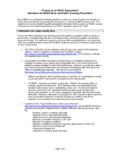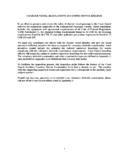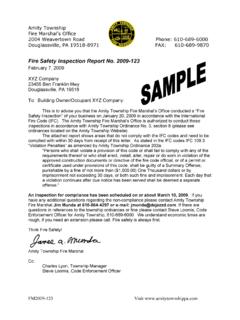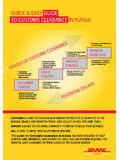Transcription of INSPECTION REFORMS: WHY, HOW, AND WITH WHAT …
1 INSPECTION REFORMS: WHY, HOW, AND WITH WHAT RESULTSBy Florentin Blanc 1 TABLE OF CONTENTS EXECUTIVE SUMMARY .. 2 CHAPTER 1. INTRODUCTION - THE INSPECTIONS ISSUE .. 4 1. What are inspections and enforcement procedures Specificities of inspections, control, enforcement vs. administrative procedures and regulations .. 4 2. Burden on businesses how do inspections weigh on business activity .. 9 3. Effectiveness and efficiency what do inspections cost (to the state) and what do they deliver .. 16 CHAPTER 2. INSPECTIONS PRACTICES PRE- reform MANY PRACTICES, NO MODEL, LITTLE COHERENCE .. 21 4. Institutional issues: transparency, duplications, goals .. 21 5. National vs. local inspections coordination issues .. 26 6. Professional background and qualification of inspectors .. 30 7. Inspections targeting and risk-based planning .. 31 CHAPTER 3.
2 REFORMING INSPECTIONS DIFFERENT CONTEXTS, DIFFERENT GOALS, DIFFERENT MODELS .. 34 8. Starting points recognising the inspections problem, mobilising support .. 34 9. Defining the goals and approach of reform .. 48 10. Driving implementation successfully .. 53 CHAPTER 4. REFORMED INSPECTIONS SOME EXAMPLES OF GOOD PRACTICE .. 60 11. The use of delegated inspections or second-level control .. 60 12. Institutional reform reducing overlaps and duplication, improving efficiency .. 64 13. Governance giving inspectorates the ability to do their job without undue influence .. 69 14. Risk-based targeting optimising effectiveness and costs .. 72 15. Promoting compliance information and guidance rather than control and sanctions .. 75 16. Sharing information reducing burden, improving planning, optimising efficiency .. 77 17. Beyond inspections sanctions and liability, acceptable risk level.
3 81 BIBILIOGRAPHY .. 87 2 EXECUTIVE SUMMARY 1. In spite of the increasing focus on improving regulations for businesses (and citizens), enforcement and delivery of these regulations, and in particular inspections, have been the object of considerably less attention. Studies and reform programmes often assume delivery, effectiveness, compliance and tend to pay too little attention to how third parties, but also the state administration, are actually supposed to work with rules in practice. There is, however, a growing body of experience and evidence, both from OECD countries and beyond, on the crucial issue of how regulation actually works: who delivers it through INSPECTION , enforcement, information activities (staff resources, structures); how interactions with citizens and businesses take place; how practices get transformed; costs, outcomes, effectiveness and efficiency.
4 2. While differences between and within countries are considerable, the picture presented by business inspections around the world is often unsatisfactory. In many jurisdictions, to at least some extent: many inspections creating significant costs for the state, and burden for businesses; insufficiently clear requirements, uncertainty, discretion etc. lead to additional barriers to growth; outcomes are disappointing in terms of securing public goods, and/or cost-effectiveness is low. 3. The reasons for this evidently vary, but a frequent pattern includes the following problems: many inspecting agencies, inspectors, and INSPECTION visits frequent overlaps, duplications, lack of coordination; insufficient risk-focus many businesses get inspected, even though their risk level is low or moderate (combination of probability and magnitude of hazard for the public); lack of consistency, coordination and coherence between agencies lack of uniform guidelines and approaches between inspectors; frequent focus on finding violations rather than improving compliance and outcomes.
5 4. Overall, high costs for state budgets usually go hand-in-hand with high costs for businesses and outcomes that are not in proportion to these costs. 5. Many countries have thus undertaken to reform inspections, starting with Mexico in 1995, many Central and Eastern European and Former Soviet countries from the late 1990s, and with prominent examples such as the UK from 2005 and the Netherlands from 2006. Among the latest initiatives are reforms in Lithuania since 2010 and Italy since 2011. To varying degrees, and with emphasis corresponding to each jurisdictions specifics, these reforms try and make the legal framework for inspections clearer and stronger, to ensure that inspections and enforcement are more risk-based and risk- 3 focused, and aim more at promoting compliance and ensuring positive outcomes than at detecting and punishing violations.
6 6. Successfully improving the inspections and enforcement system requires to address a number of issues: Institutional overlaps and structures, clarifying which agency should deal with which type of risk, and reducing duplications and overheads; Roles and responsibilities of national and local structures, combining flexibility and responsiveness with coherence and consistency; Risk-focus in resource allocation, planning and implementation of INSPECTION visits relying on a comprehensive and up-to-date information system; Transparency of requirements and clear guidance, allowing businesses to know what is expected of them, and what they can expect from inspectors. 7. While the adequate way to address each of these will of course depend on the specifics of each country s administrative structure and political economy, this report attempts to present some of the most interesting and successful experiences, as in fact problems were found to be frequently similar, suggesting that some good practices may be valid beyond the countries where they were initially pioneered.
7 4 CHAPTER 1. INTRODUCTION - THE INSPECTIONS ISSUE 1. What are inspections and enforcement procedures Specificities of inspections, control, enforcement vs. administrative procedures and regulations Inspections brief overview Historical overview 8. The question of their enforcement is probably nearly as old as the introduction of rules and laws themselves. Ancient Egypt in the New Kingdom era (16th-11th centuries BC) already had a complex administrative system with technical staff at the lower levels that were in charge of making sure that central directives ( relating to irrigation systems etc.) were properly followed. Controls of customs and taxes have also come into existence very early ancient Athens and Rome both levied fees on imports, and had agents in charge of controlling incoming ships. These agents, however, were in most cases working for private contractors who advanced the income from duties and taxes to the state, and then collected the actual payments for themselves tax farming being the norm during Ancient times, and very frequent until the 19th century CE.
8 9. Still, while these functions undoubtedly related to enforcement, control and inspections, the structures in place did not necessarily look very similar to what we would nowadays understand as inspections . These developed gradually, over a number of centuries. Inspections of business premises to verify (and promote) compliance with official requirements started at least in the Middle-Ages, when craftsmen guilds controlled the activities of their members and the quality of their production and in the 16th and 17th century, as central state power grew, several countries saw state inspections appear, such as manufacturing inspections in France, which were among the most established and long-lasting. These distant origins are important to keep in mind, for they sometimes help explain the difficulty to change, including the fact that from the onset inspections focused on issues of quality and techniques an aspect that has led to problematic situations in many countries.
9 A much broader development of INSPECTION functions came along with the onset of the industrial era, and its many new hazards, that society sought to limit or control with, for instance, the UK Factory Acts of the 19th century and to the labour inspections to enforce them, which developed from around 1850. Different types of inspections and enforcement 10. There are many different types and categories of enforcement activities, control, inspections etc. and they are called by many different names in different languages. In this report, we will be looking at inspections in the sense of visits conducted by state regulatory agencies (or by quasi-state, or even non-governmental organizations, but acting upon a specific delegation of power from the state) they are usually neither requested by, nor paid for (though there are exceptions) by the objects they visit.
10 They are mandatory checks of compliance with applicable regulations. They are conducted on the premises of the inspected entities. The focus will be on inspections of private business, because of their impact on administrative burden, investment climate and growth. 11. A certain number of verification and control activities are more difficult to strictly classify as inspections and they will only be covered to some extent in this report. 5 12. First, visits, checks, tests etc. related to the certification of given goods or processes by private certifying bodies (which is a visit that is in fact requested by the controlled entity) even though these inspections may be mandated by legislation for certain types of products, the selection of inspecting or certifying body is free, and the requesting party always has the liberty to call another one, for instance.
















